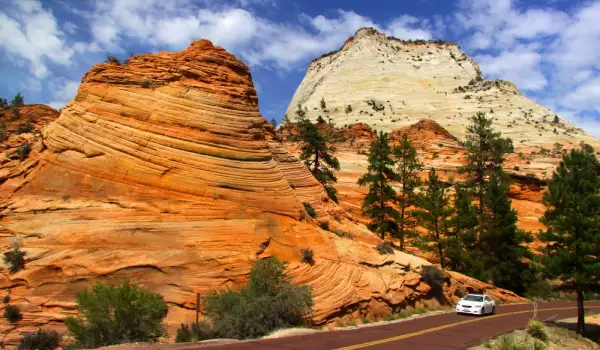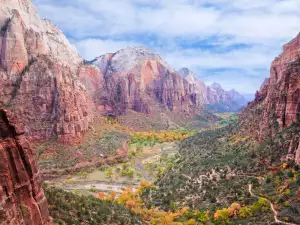Zion National Park

Zion National Park is undoubtedly one of the most beautiful parks in the U.S. Located in southwestern Utah, Zion is a unique natural complex, where over thousands of years land forces have formed majestic rock towers, canyons, tall, steep plateaus, cliffs and massive monoliths. Zion National Park is located near the town of Springdale. It was declared a national monument in 1909, and on November 19, 1919 was granted the status of a national park.
Over 2.5 million people a year come to the Zion National Park. The park does not allow driving of personal vehicles, as not to disturb the harmony of the flora and fauna. Therefore, each person leaves their car in a parking lot at the entrance of the park, whilst the Zion visitors move with buses.

Stops are a short distance from one another and each can safely descend to examine and take pictures, then continue to the next beautiful spot with another bus. To enter Zion, you pay an entrance fee of about $ 25.
Zion itself covers a vast territory - its area amounts to 590 sq. km. A very beautiful canyon is in Zion, reaching a length of 24 km and surrounded by about 800 meters of high rocky slopes. The canyon is carved in the so-called Navajo Sandstone, which is a distinctive red color. Through the region runs Virgin River, which flows into Lake Mead.
The park has a unique variety of topography, different soils and climates that are prerequisites for various natural and geographical conditions - from desert to alpine. Zion has high plateaus, forests, deserts and canyons. Here are found 291 species of birds, 78 mammals and 44 reptiles and amphibians. About 900 species of plants live in the park. Among the rare species here are bats, mountain lions, deer and the black tailed golden eagle.

Zion is the habitat of endangered birds such as the California condor and spotted owl (Strix occidentalis), so in 2007, BirdLife International announces it as an Important Bird Area.
In ancient Hebrew Zion means shelter or sanctuary. These rich natural areas were inhabited 8000 ago, shortly after, the Indians here established permanent settlements called pueblos, but evidence for this comes from the period wicker baskets found, as well as sandals and knives made of stone.
The first Europeans set foot on the territory of Zion in the 13th century, after 1850 the establishment of the first white people here began the development of the area. They were the Mormons of Salt Lake City and engaged in raising sheep, cattle and horses and farming. Zion is a place for farming activities until 1909, then it was declared a protected territory. This step leads to an exhibition consisting of paintings of the beauties of the park, which attracts the attention of the authorities.

Over time, appeared the tourist hut Zion, rail tracks and roads, resulting in the park beginning to gain popularity. The first tourist center here was built around 1950 and in 2000 was reconstructed and modernized.
Zion has a total of nine known formations resulting from the deposition of sediments from the warm shallow seas, rapids, lakes and deserts, of erosion by rivers and streams of lava. Interesting rock formations, which must be seen in Zion are Dakota - sandstone, rich in fossils Carmel, reddish cliffs of Temple-Cap, Navajo, sandstone Kayenta, rusty brown and rich in fish fossils Moenave, mineral rocks Chinle, clay Moenkopi and Kaibab, built mainly from flint and representing the same formation from which the Grand Canyon was formed.
The highest point in the National Park Zion is Horse Ranch Mountain, at 2660 m altitude, and the lowest is in Coal Pits Wash, 1500 m.















